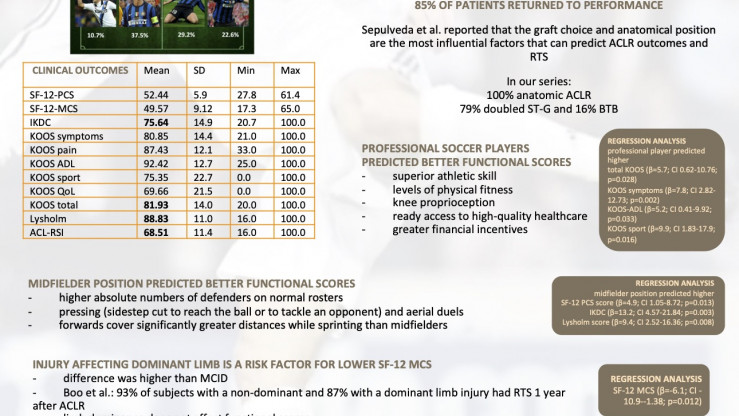Description
Background
ACL reconstruction (ACLR) is highly recommended in patients with ACL deficiency who must perform at a high physical level. A combination of functional and psychological outcome measures is necessary to provide a comprehensive evaluation of functional status after successful return to sport following ACLR.
Purpose
The purpose of this study was to identify factors associated with higher functional outcomes among soccer players who had returned to full sports participation after ACLR.
Study design: Cohort study; Level of evidence, 3
Methods
One hundred sixty-eight out of 231 patients who underwent primary unilateral arthroscopic anatomic single-bundle ACLR were available at follow-up. Postoperatively, knee function, generic health outcomes, and psychological impact were assessed using the IKDC, the KOOS, the LysholmKnee Scoring Scale, the SF-12, and the ACL return to sports after injury (ACL-RSI) scale.
Results
After a mean follow-up of 35.5±22.6 months, 85% of soccer players returned to performance. Midfielder position was associated with a better SF-12 PCS score (p=0.013), IKDC (p=0.003), total KOOS (p<0.001), KOOS symptoms (p=0.004), KOOS pain (p=0.029), KOOS-ADL (p=0.044), KOOS sport (p=0.001), KOOS-QoL (p<0.001), and Lysholm score (p=0.008). Playing only on natural grass was associated with lower SF-12 PCS scores (p=0.003), total KOOS (p=0.001), and KOOS sport (p=0.011). Playing only on artificial turf was associated with lower Lysholm score (p=0.018) and total KOOS (p=0.014). The contact mechanism was associated with higher IKDC (p=0.044) and KOOS-QoL (p=0.048), and injury affecting the dominant limb was associated withlower SF-12 MCS (p=0.012). Playing at a nonprofessional level was associated with lower total KOOS (p=0.028), KOOS symptoms (p=0.002), KOOS-ADL (p=0.033), and KOOS sports(p=0.016).
Conclusions
Professional soccer players and the midfielder position are associated with better functional scores upon returning to the sport. A history of noncontact ACL injury and playing on a single type of surface are associated with lower functional outcomes upon returning to the sport. Lower mental health scores can be expected after injury of the dominant limb.




